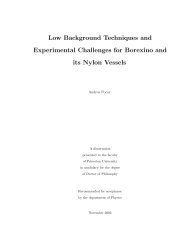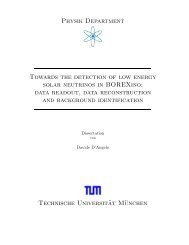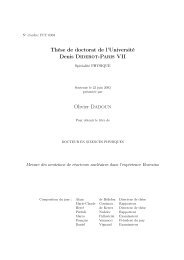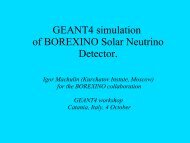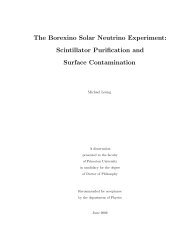Development of a Liquid Scintillator and of Data ... - Borexino - Infn
Development of a Liquid Scintillator and of Data ... - Borexino - Infn
Development of a Liquid Scintillator and of Data ... - Borexino - Infn
Create successful ePaper yourself
Turn your PDF publications into a flip-book with our unique Google optimized e-Paper software.
5 Particle Identification with a Neural Network<br />
5.1.3 Pulse-Shape-Discrimination<br />
The intensity <strong>of</strong> photons from a scintillation event as a function <strong>of</strong> time can be divided into<br />
at least two components, fast <strong>and</strong> slow. The fast component has a decay time equal to the<br />
fluorescence lifetime <strong>of</strong> the fluorescing species (the fluorescence solute). The slow component<br />
has a decay time which is diffusion controlled. It has been shown to be due to the annihilation<br />
<strong>of</strong> two triplet excited molecules Ì Ì Ë Ë . The production <strong>of</strong> triplet excited molecules<br />
is related in part to the specific ionization <strong>of</strong> the excitation particle: The higher the specific<br />
ionization <strong>of</strong> the particle, the more triplet excited molecules are created. Two different types <strong>of</strong><br />
particle which produce the same intensity <strong>of</strong> the fast component will have different intensities<br />
<strong>of</strong> the slow component. Thus it is possible with pulse shape discrimination to distinguish two<br />
types <strong>of</strong> particles with different specific ionization, especially electrons from heavy particles<br />
like neutrons or alpha particles. The ability to discriminate between « <strong>and</strong> ¬ or radiation is<br />
based on the difference in the tail <strong>of</strong> the time distributions <strong>of</strong> the scintillator decay, as shown<br />
in fig. 5.2 (see also table 4.1).<br />
5.1.4 The Flash-ADC<br />
In collaboration with the company CAEN, a 400 MHz waveform digitizer was developed for<br />
BOREXINO, which was first tested in the CTF2. Its basic function is to digitize the analog<br />
64<br />
Figure 5.2: Time decay distribution <strong>of</strong> È ÈÈÇ Ð for emission excited by « or ¬<br />
radiation.



